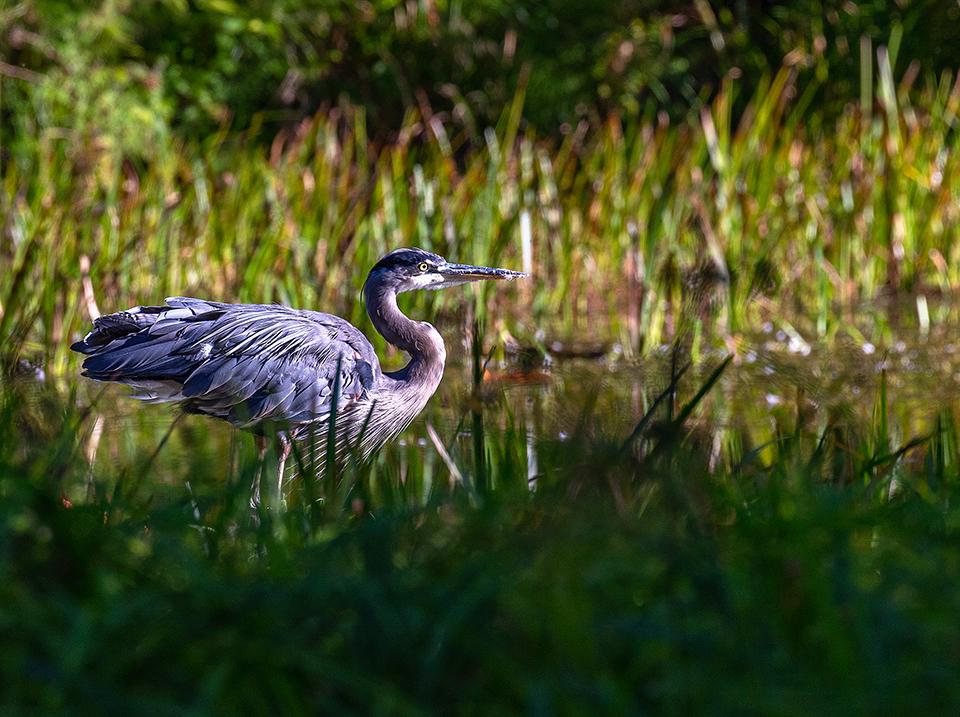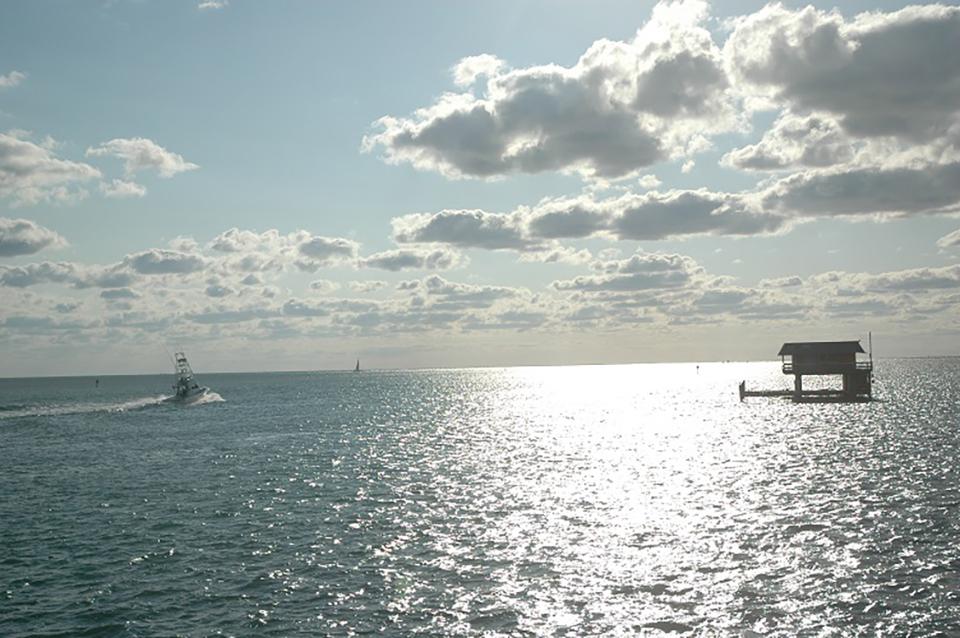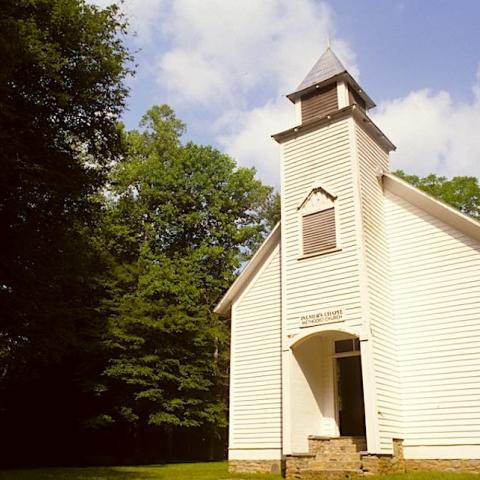
A view of Casa Grande along the Lost Mine Trail, Big Bend National Park / Rebecca Latson
June marks not only the beginning of summer, but is also notable for Father’s Day and Flag Day, in addition to being the month in which Big Bend, Great Smoky Mountains, Biscayne, Mesa Verde, and Olympic national parks were established. Whew! June is a busy month! Test your knowledge about these national park notables before looking at the answers at the bottom of the page.
1. Big Bend has many hiking trails on which you can explore desert and volcanic environments and capture expansive landscape images with your camera. How many miles of trails does this national park have?
a) 75
b) 100
c) 125
d) 150
2. True or False: You can legally cross into Mexico from Big Bend National Park.
a) True
b) False

A view of the landscape from the Bunion, Great Smoky Mountains National Park / National Park Service
3. The rocks that make up Great Smoky Mountains National Park are mostly:
a) igneous
b) sedimentary
c) metamorphic
d) all of the above
4. There are 60 species of “invasive exotics” at over 600 sites in the Smokies. These non-native plants were introduced by human activities and are out-competing and displacing native species within the park. One of the nine invasive species that are of greatest concern to the park service exotic management staff is:
a) kudzu
b) blue cohosh
c) sweetshrub
d) spicebush

Biscayne Bay water near Elliott Key, Biscayne National Park / NPS-Matt Johnson
5. Biscayne Bay, in Biscayne National Park, has seen quite a bit of action over its 10,000 years of human influence, with archeological artifacts left by “pioneers, farmers, pirates, rumrunners, gunrunners, drug smugglers, the international maritime trade, and wreckers.” This human history led to a number of economic activities (as inferred by some of the above listing). One such economic activity was:
a) sponge fishing
b) coral transplanting
c) salmon farming
d) oil drilling
6. Like the Great Smoky Mountains, Biscayne Bay National Park has its share of invasive species. One such species is:
a) the cherubfish
b) the checkered blenny
c) the lionfish
d) the bonnetmouth

A cliff dwelling view at Mesa Verde National Park / Rebecca Latson
7. The Ancestral Puebloans made the landscape within Mesa Verde National Park their home for how many years?
a) 550
b) 700
c) 950
d) 1300

Long House, Mesa Verde National Park / Rebecca Latson
8. True or False: the cliff dwelling named Long House is located on Chapin Mesa.
a) True
b) False

Preparing for takeoff, Hoh Rain Forest, Olympic National Park / Rebecca Latson
9. As you drive toward the parking lot of the Hoh Rain Forest Visitor Center, you’ll pass by a small body of water to your left. On occasion, you might see a Great Blue Heron standing statue-still as it fishes the water for a meal. This beautiful bird is one of how many bird species found in Olympic National Park?
a) 100
b) 300
c) 75
d) 200
10. There are _____ Olympic Peninsula tribes that continue to recognize a relationship to Olympic National Park based on “traditional land use, origin, beliefs, mythology and spiritual beliefs and practices.”
a) five
b) eight
c) ten
d) thirteen
Trivia

Anne Davis, Great Smoky Mountains National Park / National Park Service
“’Why don’t we have a national park in the Smokies?’ It's the question that sparked the movement to create Great Smoky Mountains National Park, and it was spoken by Anne Davis, the "Mother of the Park." Following a trip to several national parks in the western states, Anne and her husband, Willis Davis, co-founded the Great Smoky Mountains Conservation Association, one of the most influential organizations that supported the creation of the park.” To learn more about the women of the Smokies, click here.

Stiltsville, Biscayne National Park / NPS-Matt Johnson
“Seeming to float above Biscayne Bay's shallow seagrass beds, Stiltsville has a colorful history that dates back to the 1930s, when "Crawfish Eddie Walker" built the first shack on stilts above the water. Over the years more buildings were constructed, and the area took on an aura of mystery. Accessible only by water, the area was the place to see and be seen when visiting the winter resorts on nearby Miami Beach. Stories of illegal alcohol and gambling led to several police raids on the Bikini Club and Quarterdeck Club. At its peak in 1960, there were 27 structures on the flats, but hurricanes, fires and the ravages of being in such an exposed place made every building relatively short-lived.” To learn more about Stiltsville, click here.

Western tanager (Piranga ludoviciana), Mesa Verde National Park / National Park Service
“Mesa Verde contains several habitats that support a great diversity of resident and migratory wildlife. The park has been named a Colorado Important Bird Area (IBA) by the Audubon Society, and has two Protected Activity Centers and three breeding Core Areas for the threatened Mexican Spotted Owl totaling 5,312 acres. The Colorado Natural Heritage Program and The Nature Conservancy have classified all of Mesa Verde National Park within their Network of Conservation Areas (NCA) because of exceptional occurrences of rare plant and animal species.” To read more about the animal species within this national park, click here.
Quiz Answers
1d
“Big Bend is a hiker's paradise containing the largest expanse of roadless public lands in Texas. More than 150 miles of trails offer opportunities for day hikes or backpacking trips.” To find a trail just right for you, click here.
2a True
“Yes, visitors can legally cross into Mexico through the Boquillas Crossing Port of Entry. This Class B port of entry is open from 9:00am-6:00pm, Friday to Monday during summer months, and 8:00am-5:00pm, Wednesday to Sunday during the winter.” Note: due to Covid-19, the Port of Entry is currently closed.
3b
Ok, this is sort of a trick question. The Great Smoky Mountains area has igneous, sedimentary, and metamorphic rocks, but, the questions is asking what rocks mostly make up this park. “The landscape of the Great Smokies has undergone profound changes throughout the ages. The rocks in this area are mostly of a sedimentary type. That is, they were formed by accumulations of soil, silt, sand, and gravel deposited into a huge shallow sea. Over millions of years, more and more sediments were deposited, becoming layers of hard rock some nine miles or more thick.” To learn more about the natural features of this park, click here.
4a
“Kudzu is a fast-growing Asian vine that covers some seven million acres of land (an area larger than Vermont) in the southeastern United States. Prior to 1953 the plant was widely grown as livestock forage and as a means of controlling erosion. Park crews have largely contained the spread of kudzu in the Smokies, though they continue to monitor 116 sites and treat them as needed.”
5a
“One of the most interesting economic activities the Bay supported was sponge fishing. Sponge fishing began in the early 1800s. This economic activity was grandfathered in when the park was created, primarily on grounds that the sponge fishermen had a unique subculture that was worthy of preservation. By the late 1980s about 40 fishermen, all Cuban immigrants, were still harvesting sponges in park waters. The Park Service finally banned the practice in 1999.” To read more of this article about Biscayne’s history written for the Traveler by Professor Robert Janiskee, click here. To see more Biscayne National Park articles written for the Traveler over the years, click here.
6c
Although “impossibly beautiful,” the lionfish is also “incredibly invasive,” according to a 2019 article written for the Traveler by Erika Zambello. To read about more invasive species within this national park, click here. To learn about non-invasive fish species that have been spotted in the park, click here.
7b
“Ancestral Pueblo peoples made Mesa Verde their home from about 550 to 1300 CE. For more than 700 years they and their descendants lived and flourished here.” To learn more about the Ancestral Pueblo People of Mesa Verde, click here.
8b False
Long House is located on Wetherill Mesa. To learn more about Long House architectural features, click here.
9b
There are 300 species of birds “that add color and song to the diverse habitats found in Olympic National Park,” including ruffled grouse, woodpeckers, ravens, belted kingfishers, and blue herons.
10b
“Eight Olympic Peninsula tribes continue to recognize a relationship to the park based on traditional land use, origin, beliefs, mythology and spiritual beliefs and practices. These tribes are the Lower Elwha Klallam, Jamestown S'Klallam, Port Gamble S'Klallam, Skokomish, Quinault, Hoh, Quileute, and Makah. It was the ancestors of these tribes that lived throughout the Olympic Peninsula, but ceded their lands and waters to the federal government through treaties in 1855 and 1856 and now live on reservations along the shores of the peninsula.” To read more about the ancient peoples and area tribes of the Olympic Peninsula, click here.
Note: Different websites may have different national park establishment dates, so, I used this NPS publication as the standard.




 Support Essential Coverage of Essential Places
Support Essential Coverage of Essential Places







Add comment